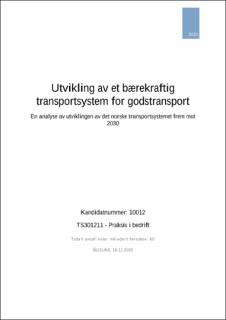| dc.contributor.advisor | Aaby, Bernt Christoffer | |
| dc.contributor.advisor | Andersen, Øivind | |
| dc.contributor.author | Helseth, Ingvild Lunden | |
| dc.date.accessioned | 2021-09-24T19:18:27Z | |
| dc.date.available | 2021-09-24T19:18:27Z | |
| dc.date.issued | 2020 | |
| dc.identifier | no.ntnu:inspera:72403850:72406241 | |
| dc.identifier.uri | https://hdl.handle.net/11250/2782209 | |
| dc.description.abstract | Oppgaven studerer utviklingen av et bærekraftig transportsystem for godstransport i Norge frem mot 2030.
Gjennom Parisavtalen har Norge forpliktet seg til å redusere nasjonale klimagassutslipp med 50-55% innen 2030. Oppgaven har, gjennom tre ulike scenarioanalyser, undersøkt og kartlagt om transportsektoren kan bidra til at Norge når klimaforpliktelsene for 2030. Videre har oppgaven vurdert om null- og lavutslippsteknologi og endring i logistikkorganisering er nok for å legge til rette for en bærekraftig utvikling i norsk godstransport og for å bidra til å oppnå klimaforpliktelsene.
Med økende transportarbeid, høyere utslipp og mer transport på veiene kan ikke dagens transportutvikling beskrives som bærekraftig. Det er en utvikling som gjør at transportsektoren ikke er i stand til å bidra til at Norge oppfyller klimaforpliktelsene vedtatt i Parisavtalen. Transportsektoren, med en forventet transportvekst, utvikler seg i strid med klimaforpliktelsene når man tar utgangspunkt i dagens teknologi.
Null- og lavutslippsteknologi vil ikke få oppslutning i transportsektoren før den blir økonomisk moden, eller ved at det blir etablert støtteordninger. God virkemiddelbruk er nødvendig for å nå klimamålene, og støtteordninger for innfasing av lavutslippsteknologi vil være avgjørende i tidlig markedsfase for en grønn omstilling av lastbærere.
En overgang til en desentralisert terminalstruktur, med flere nasjonale huber langs kysten i Norge, vil redusere innlandstrafikken og resulterer i mer sjøtransport med last fra Sentral-Europa.
Null- og lavutslippsteknologi og logistikkendringer har kun en «skadereduserende» effekt, der det i analysen kommer frem at utslippene (fortsetter å) øke(r) ved alle scenarioene utenom ved høy innfasing og ved en kombinasjon av begge tiltakene.
Null- og lavutslippsteknologi og logistikkorganisering er ikke gode nok utslippsreduserende tiltak frem mot 2030, dersom transportsektoren skal bidra til å nå målet om 55 % reduksjon av klimagasser. Man er avhengig av at summen av flere tiltak kan gi gode nok utslippskutt.
Transportsektoren vil ikke være i stand til å bidra til at Norge når sine klimaforpliktelser frem mot 2030 med en forventet transportvekst med kun innfasing av null- og lavutslippsteknolog og endringer i logistikkorganisering som tiltak. | |
| dc.description.abstract | The thesis studies the development of a sustainable transport system for freight transport in Norway towards 2030.
Through the Paris Agreement, Norway has committed itself to reducing national greenhouse gas emissions by 50-55% by 2030. The task has, through three different scenario analyzes, investigated whether the transport sector can contribute to Norway reaching its climate commitments for 2030.
Furthermore, the thesis has assessed whether low-emission technology and changes in logistics organization are sufficient to facilitate sustainable development in Norwegian freight transport and to contribute to achieving climate commitments.
With increasing transport, higher emissions and more transport on the roads, current transport development cannot be described as sustainable. This is a development that means that the transport sector is not able to contribute to Norway fulfilling the climate obligations adopted in the Paris Agreement. The transport sector, with an expected growth, is developing in conflict with climate commitments when based on current technology.
Zero and low-emission technology will not gain support in the transport sector until it becomes economically mature, or through the establishment of support schemes. Good use of instruments is necessary to achieve the climate goals, and support schemes for phasing in low-emission technology will be crucial in the early market phase for a green transition of load carriers.
A transition to a decentralized terminal structure, with more national hubs along the coast of Norway, will reduce inland traffic and result in more sea transport with cargo from Europe.
Low emissions and logistics changes only have a «damage-reducing» effect, where the analysis shows that the emissions (continue to) increase in all scenarios except during high phasing and by a combination of both measures.
Low-emission technology and logistics organization are not good enough emission reduction measures until 2030, if the transport sector is to contribute to achieving the goal of a 55% reduction in greenhouse gases. One is dependent on the fact that the sum of several measures can provide good enough emission cuts.
The transport sector will not be able to contribute to Norway reaching its climate commitments by 2030, with only the phasing in of zero- and low-emission technology and changes in logistics organization as a measure. | |
| dc.language | nob | |
| dc.publisher | NTNU | |
| dc.title | Utvikling av et bærekraftig transportsystem for godstransport.
En analyse av utviklingen av det norske transportsystemet frem mot 2030 | |
| dc.type | Bachelor thesis | |
